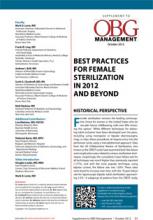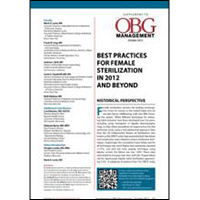User login
Female sterilization remains the leading contraceptive choice for women in the United States who do not plan future childbearing, with over 40% choosing this option.1 While different techniques for obtaining tubal occlusion have been developed over the years, including using monopolar or bipolar electrosurgery, rings, or clips, these procedures all require entry into the peritoneal cavity using a transabdominal approach. Data from the US Collaborative Review of Sterilization, also known as the CREST study have examined both the failure and complication rates related to various sterilization techniques.
Female sterilization remains the leading contraceptive choice for women in the United States who do not plan future childbearing, with over 40% choosing this option.1 While different techniques for obtaining tubal occlusion have been developed over the years, including using monopolar or bipolar electrosurgery, rings, or clips, these procedures all require entry into the peritoneal cavity using a transabdominal approach. Data from the US Collaborative Review of Sterilization, also known as the CREST study have examined both the failure and complication rates related to various sterilization techniques.
Female sterilization remains the leading contraceptive choice for women in the United States who do not plan future childbearing, with over 40% choosing this option.1 While different techniques for obtaining tubal occlusion have been developed over the years, including using monopolar or bipolar electrosurgery, rings, or clips, these procedures all require entry into the peritoneal cavity using a transabdominal approach. Data from the US Collaborative Review of Sterilization, also known as the CREST study have examined both the failure and complication rates related to various sterilization techniques.

